2011 INFINITI QX56 lock
[x] Cancel search: lockPage 4559 of 5598
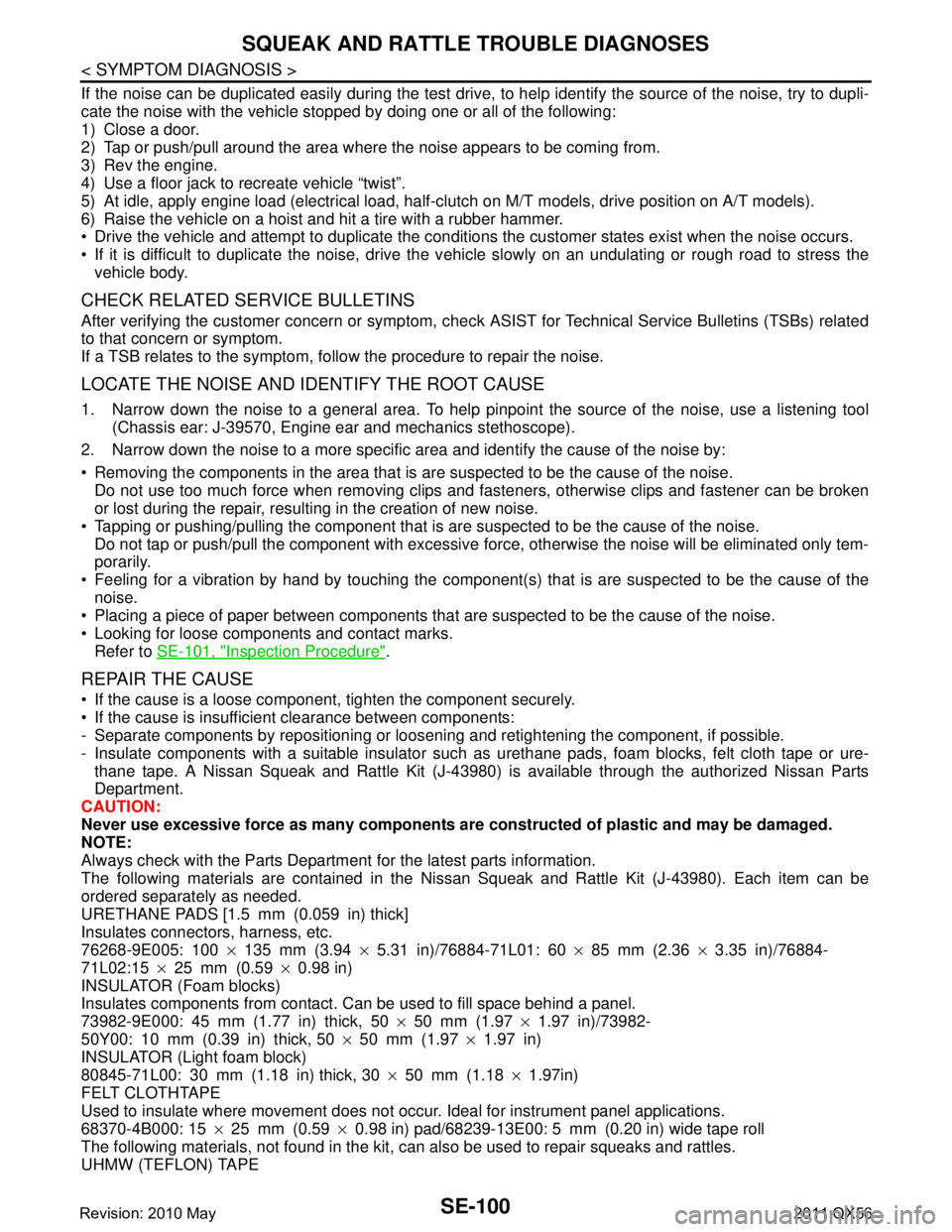
SE-100
< SYMPTOM DIAGNOSIS >
SQUEAK AND RATTLE TROUBLE DIAGNOSES
If the noise can be duplicated easily during the test drive, to help identify the source of the noise, try to dupli-
cate the noise with the vehicle stopped by doing one or all of the following:
1) Close a door.
2) Tap or push/pull around the area where the noise appears to be coming from.
3) Rev the engine.
4) Use a floor jack to recreate vehicle “twist”.
5) At idle, apply engine load (electrical load, half-cl utch on M/T models, drive position on A/T models).
6) Raise the vehicle on a hoist and hit a tire with a rubber hammer.
Drive the vehicle and attempt to duplicate the conditions the customer states exist when the noise occurs.
If it is difficult to duplicate the noise, drive the v ehicle slowly on an undulating or rough road to stress the
vehicle body.
CHECK RELATED SERVICE BULLETINS
After verifying the customer concern or symptom, chec k ASIST for Technical Service Bulletins (TSBs) related
to that concern or symptom.
If a TSB relates to the symptom, follo w the procedure to repair the noise.
LOCATE THE NOISE AND IDENTIFY THE ROOT CAUSE
1. Narrow down the noise to a general area. To help pi npoint the source of the noise, use a listening tool
(Chassis ear: J-39570, Engine ear and mechanics stethoscope).
2. Narrow down the noise to a more specific area and identify the cause of the noise by:
Removing the components in the area that is are suspected to be the cause of the noise.
Do not use too much force when removing clips and fasteners, otherwise clips and fastener can be broken
or lost during the repair, resulting in the creation of new noise.
Tapping or pushing/pulling the component that is are suspected to be the cause of the noise.
Do not tap or push/pull the component with excessive force, otherwise the noise will be eliminated only tem-
porarily.
Feeling for a vibration by hand by touching the component (s) that is are suspected to be the cause of the
noise.
Placing a piece of paper between components that are suspected to be the cause of the noise.
Looking for loose components and contact marks. Refer to SE-101, "
Inspection Procedure".
REPAIR THE CAUSE
If the cause is a loose component, tighten the component securely.
If the cause is insufficient clearance between components:
- Separate components by repositioning or loos ening and retightening the component, if possible.
- Insulate components with a suitable insulator such as urethane pads, foam blocks, felt cloth tape or ure-
thane tape. A Nissan Squeak and Rattle Kit (J-43980) is available through the authorized Nissan Parts
Department.
CAUTION:
Never use excessive force as many components are constructed of plastic and may be damaged.
NOTE:
Always check with the Parts Departm ent for the latest parts information.
The following materials are contained in the Nissan Squeak and Rattle Kit (J-43980). Each item can be
ordered separately as needed.
URETHANE PADS [1.5 mm (0.059 in) thick]
Insulates connectors, harness, etc.
76268-9E005: 100 ×135 mm (3.94 ×5.31 in)/76884-71L01: 60 ×85 mm (2.36 ×3.35 in)/76884-
71L02:15 ×25 mm (0.59 ×0.98 in)
INSULATOR (Foam blocks)
Insulates components from contact. Can be used to fill space behind a panel.
73982-9E000: 45 mm (1.77 in) thick, 50 ×50 mm (1.97 ×1.97 in)/73982-
50Y00: 10 mm (0.39 in) thick, 50 ×50 mm (1.97 ×1.97 in)
INSULATOR (Light foam block)
80845-71L00: 30 mm (1.18 in) thick, 30 ×50 mm (1.18 ×1.97in)
FELT CLOTHTAPE
Used to insulate where movement does not occu r. Ideal for instrument panel applications.
68370-4B000: 15 ×25 mm (0.59 ×0.98 in) pad/68239-13E00: 5 mm (0.20 in) wide tape roll
The following materials, not found in the kit, can also be used to repair squeaks and rattles.
UHMW (TEFLON) TAPE
Revision: 2010 May2011 QX56
Page 4560 of 5598
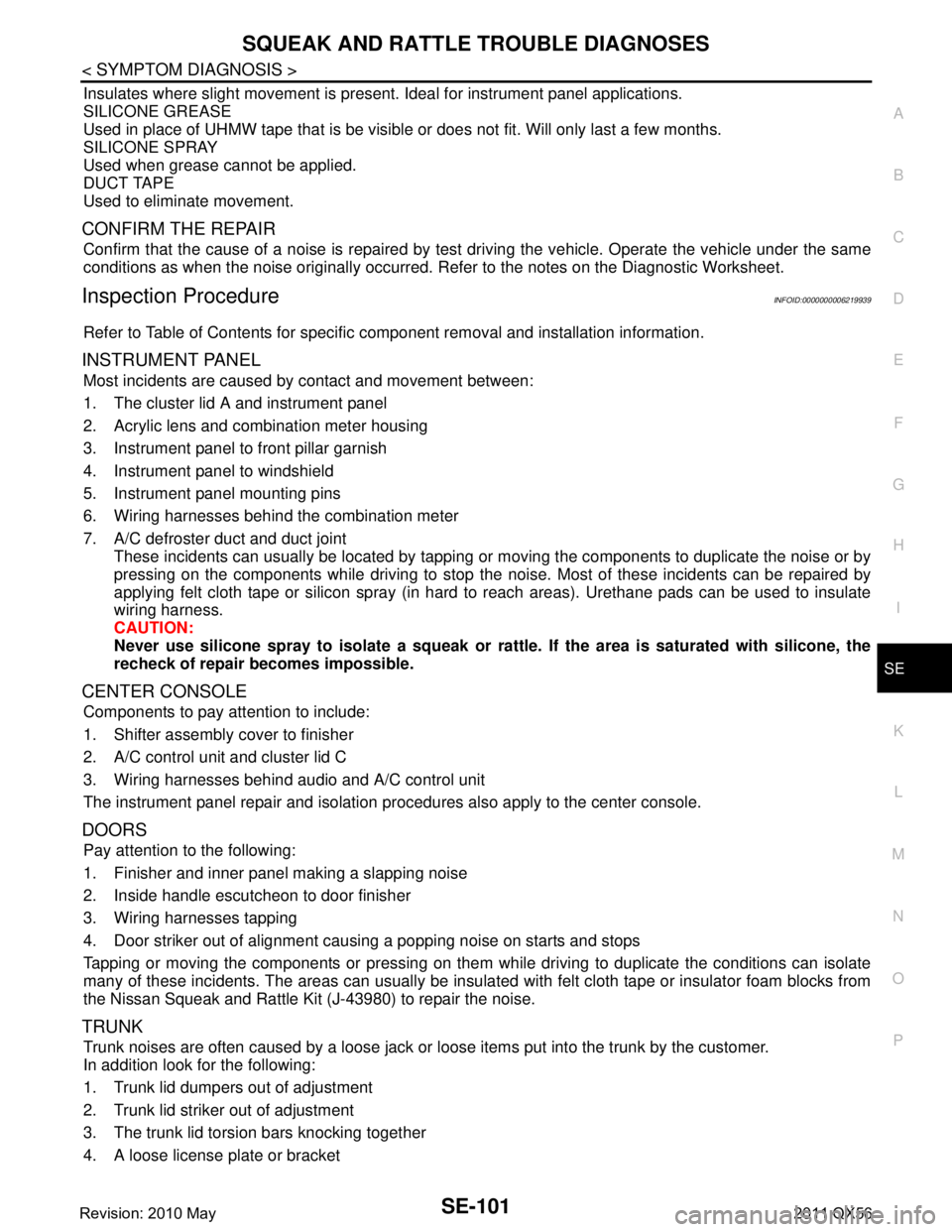
SQUEAK AND RATTLE TROUBLE DIAGNOSESSE-101
< SYMPTOM DIAGNOSIS >
C
DE
F
G H
I
K L
M A
B
SE
N
O P
Insulates where slight movement is present. Ideal for instrument panel applications.
SILICONE GREASE
Used in place of UHMW tape that is be visible or does not fit. Will only last a few months.
SILICONE SPRAY
Used when grease cannot be applied.
DUCT TAPE
Used to eliminate movement.
CONFIRM THE REPAIR
Confirm that the cause of a noise is repaired by test driving the vehicle. Operate the vehicle under the same
conditions as when the noise originally occurred. Refer to the notes on the Diagnostic Worksheet.
Inspection ProcedureINFOID:0000000006219939
Refer to Table of Contents for specific component removal and installation information.
INSTRUMENT PANEL
Most incidents are caused by contact and movement between:
1. The cluster lid A and instrument panel
2. Acrylic lens and combination meter housing
3. Instrument panel to front pillar garnish
4. Instrument panel to windshield
5. Instrument panel mounting pins
6. Wiring harnesses behind the combination meter
7. A/C defroster duct and duct joint
These incidents can usually be located by tapping or moving the components to duplicate the noise or by
pressing on the components while driving to stop the noise. Most of these incidents can be repaired by
applying felt cloth tape or silicon spray (in hard to reach areas). Urethane pads can be used to insulate
wiring harness.
CAUTION:
Never use silicone spray to isolate a squeak or ra ttle. If the area is saturated with silicone, the
recheck of repair becomes impossible.
CENTER CONSOLE
Components to pay attention to include:
1. Shifter assembly cover to finisher
2. A/C control unit and cluster lid C
3. Wiring harnesses behind audio and A/C control unit
The instrument panel repair and isolation pr ocedures also apply to the center console.
DOORS
Pay attention to the following:
1. Finisher and inner panel making a slapping noise
2. Inside handle escutcheon to door finisher
3. Wiring harnesses tapping
4. Door striker out of alignment causing a popping noise on starts and stops
Tapping or moving the components or pressing on them while driving to duplicate the conditions can isolate
many of these incidents. The areas can usually be insula ted with felt cloth tape or insulator foam blocks from
the Nissan Squeak and Rattle Kit (J-43980) to repair the noise.
TRUNK
Trunk noises are often caused by a loose jack or loose items put into the trunk by the customer.
In addition look for the following:
1. Trunk lid dumpers out of adjustment
2. Trunk lid striker out of adjustment
3. The trunk lid torsion bars knocking together
4. A loose license plate or bracket
Revision: 2010 May2011 QX56
Page 4561 of 5598

SE-102
< SYMPTOM DIAGNOSIS >
SQUEAK AND RATTLE TROUBLE DIAGNOSES
Most of these incidents can be repaired by adjusting, securing or insulating the item(s) or component(s) caus-
ing the noise.
SUNROOF/HEADLINING
Noises in the sunroof/headlining area c an often be traced to one of the following:
1. Sunroof lid, rail, linkage or seals making a rattle or light knocking noise
2. Sunvisor shaft shaking in the holder
3. Front or rear windshield touching headlining and squeaking
Again, pressing on the components to stop the noise while duplicating the conditions can isolate most of these
incidents. Repairs usually consist of insulating with felt cloth tape.
SEATS
When isolating seat noise it's important to note the position the seats in and the load placed on the seat when
the noise occurs. These conditions should be duplicated when verifying and isolating the cause of the noise.
Cause of seat noise include:
1. Headrest rods and holder
2. A squeak between the seat pad cushion and frame
3. The rear seatback lock and bracket
These noises can be isolated by moving or pressing on the suspected components while duplicating the con-
ditions under which the noise occurs.Most of these incidents can be repaired by repositioning the component
or applying urethane tape to the contact area.
UNDERHOOD
Some interior noise may be caused by components under the hood or on the engine wall. The noise is then
transmitted into the passenger compartment.
Causes of transmitted underhood noise include:
1. Any component mounted to the engine wall
2. Components that pass through the engine wall
3. Engine wall mounts and connectors
4. Loose radiator mounting pins
5. Hood bumpers out of adjustment
6. Hood striker out of adjustment
These noises can be difficult to isolate since they cannot be reached from the interior of the vehicle. The best
method is to secure, move or insulate one component at a time and test drive the \
vehicle. Also, engine RPM
or load can be changed to isolate the noise. Repairs can usually be made by moving, adjusting, securing, or
insulating the component causing the noise.
Revision: 2010 May2011 QX56
Page 4565 of 5598
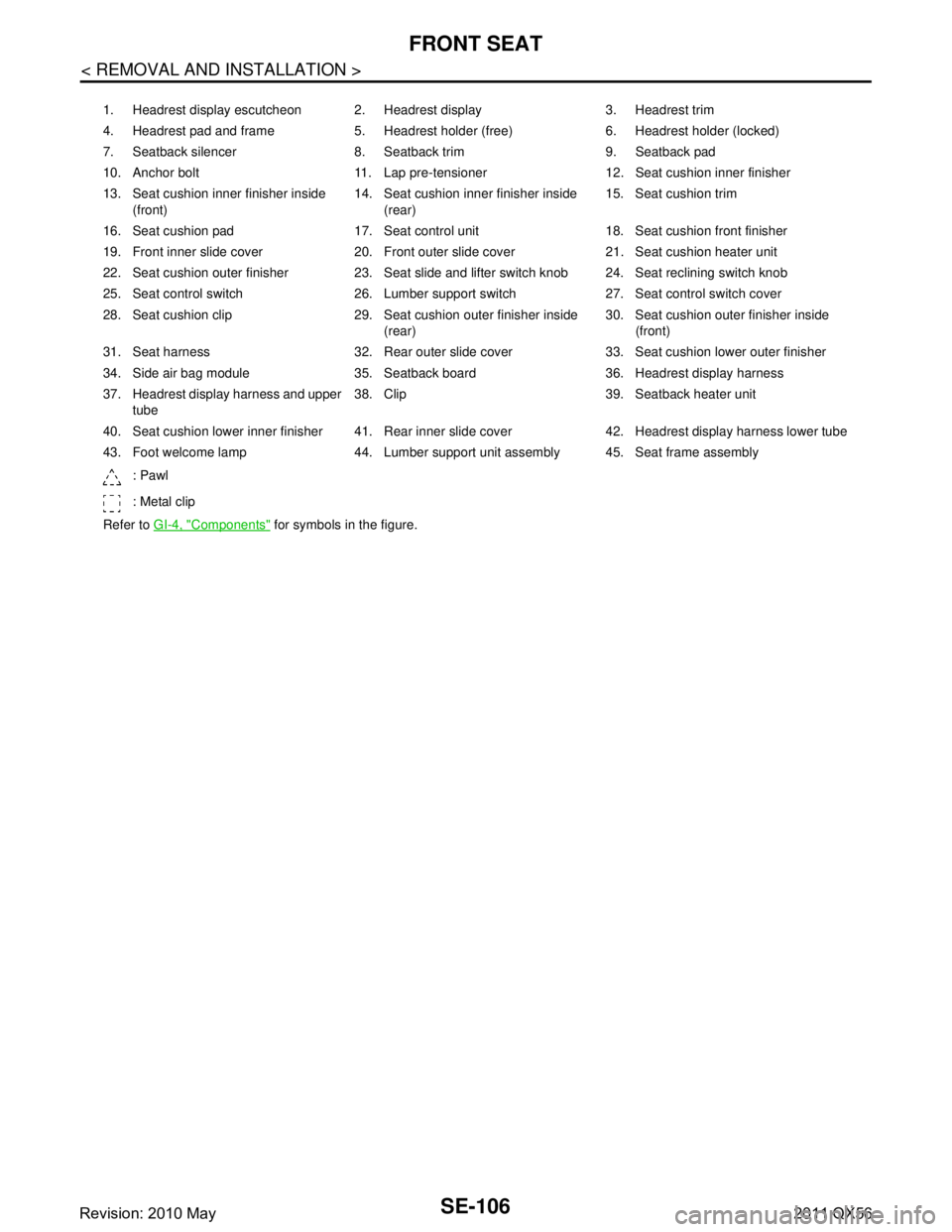
SE-106
< REMOVAL AND INSTALLATION >
FRONT SEAT
1. Headrest display escutcheon 2. Headrest display 3. Headrest trim
4. Headrest pad and frame 5. Headrest holder (free) 6. Headrest holder (locked)
7. Seatback silencer 8. Seatback trim 9. Seatback pad
10. Anchor bolt 11. Lap pre-tensioner 12. Seat cushion inner finisher
13. Seat cushion inner finisher inside (front) 14. Seat cushion inner finisher inside
(rear) 15. Seat cushion trim
16. Seat cushion pad 17. Seat control unit 18. Seat cushion front finisher
19. Front inner slide cover 20. Front outer slide cover 21. Seat cushion heater unit
22. Seat cushion outer finisher 23. Seat slide and lifter switch knob 24. Seat reclining switch knob
25. Seat control switch 26. Lumber support switch 27. Seat control switch cover
28. Seat cushion clip 29. Seat cushion outer finisher inside (rear)30. Seat cushion outer finisher inside
(front)
31. Seat harness 32. Rear outer slide cover 33. Seat cushion lower outer finisher
34. Side air bag module 35. Seatback board 36. Headrest display harness
37. Headrest display harness and upper tube 38. Clip 39. Seatback heater unit
40. Seat cushion lower inner finisher 41. Rear inner slide cover 42. Headrest display harness lower tube
43. Foot welcome lamp 44. Lumber support unit assembly 45. Seat frame assembly : Pawl
: Metal clip
Refer to GI-4, "
Components" for symbols in the figure.
Revision: 2010 May2011 QX56
Page 4566 of 5598
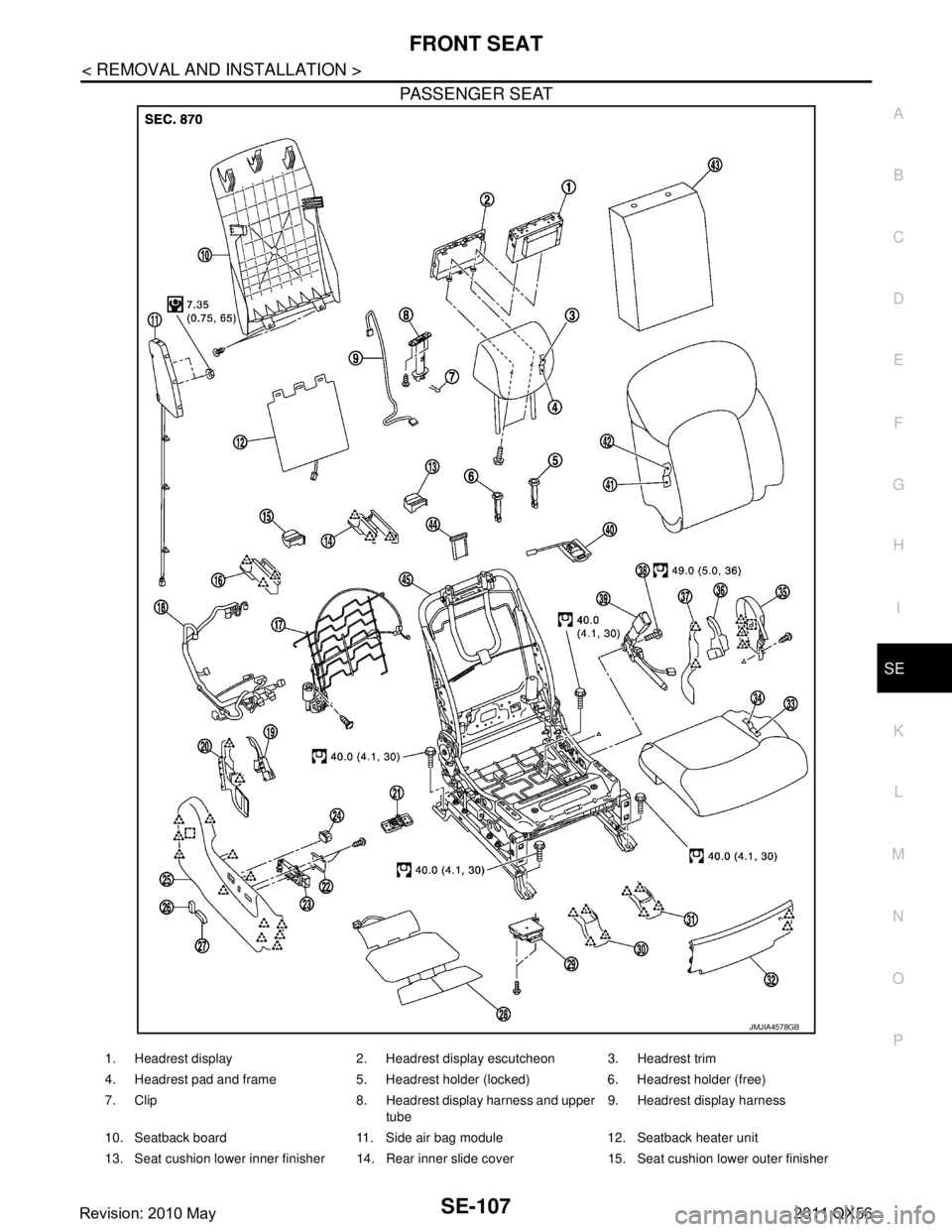
FRONT SEATSE-107
< REMOVAL AND INSTALLATION >
C
DE
F
G H
I
K L
M A
B
SE
N
O P
PASSENGER SEAT
JMJIA4578GB
1. Headrest display 2. Headrest display escutcheon 3. Headrest trim
4. Headrest pad and frame 5. Headrest holder (locked) 6. Headrest holder (free)
7. Clip 8. Headrest display harness and upper tube9. Headrest display harness
10. Seatback board 11. Side air bag module 12. Seatback heater unit
13. Seat cushion lower inner finisher 14. Rear inner slide cover 15. Seat cushion lower outer finisher
Revision: 2010 May2011 QX56
Page 4568 of 5598
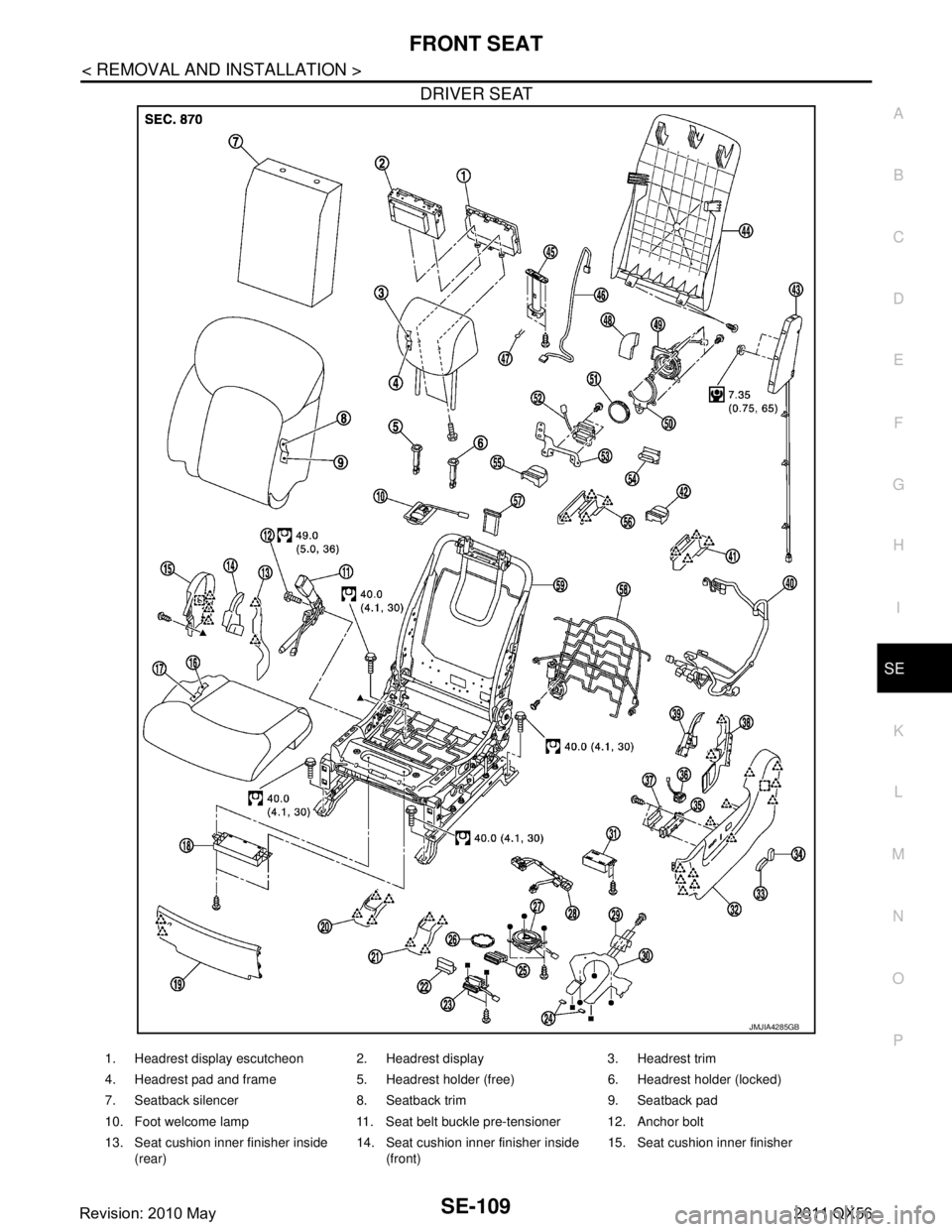
FRONT SEATSE-109
< REMOVAL AND INSTALLATION >
C
DE
F
G H
I
K L
M A
B
SE
N
O P
DRIVER SEAT
JMJIA4285GB
1. Headrest display escutcheon 2. Headrest display 3. Headrest trim
4. Headrest pad and frame 5. Headrest holder (free) 6. Headrest holder (locked)
7. Seatback silencer 8. Seatback trim 9. Seatback pad
10. Foot welcome lamp 11. Seat belt buckle pre-tensioner 12. Anchor bolt
13. Seat cushion inner finisher inside (rear) 14. Seat cushion inner finisher inside
(front) 15. Seat cushion inner finisher
Revision: 2010 May2011 QX56
Page 4570 of 5598
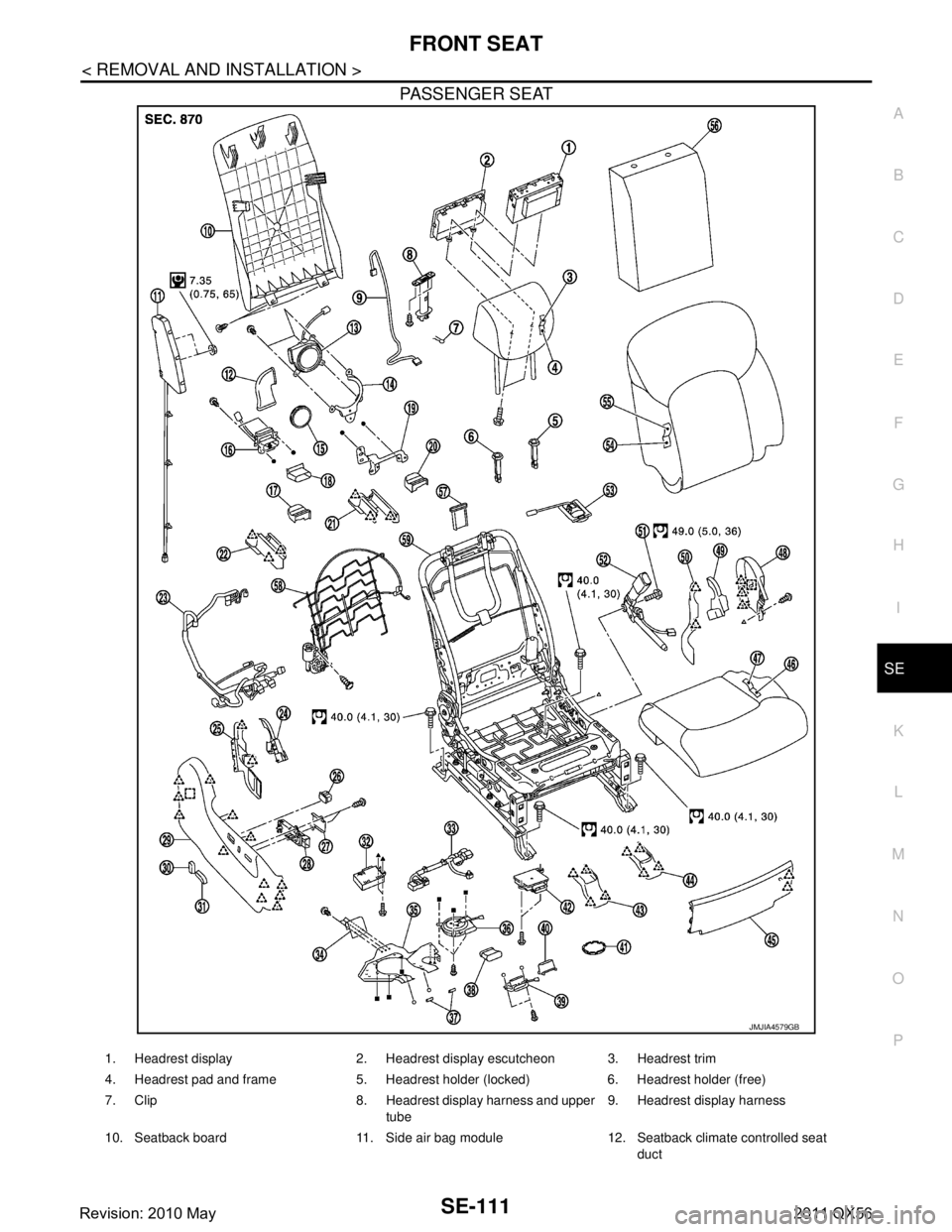
FRONT SEATSE-111
< REMOVAL AND INSTALLATION >
C
DE
F
G H
I
K L
M A
B
SE
N
O P
PASSENGER SEAT
JMJIA4579GB
1. Headrest display 2. Headrest display escutcheon 3. Headrest trim
4. Headrest pad and frame 5. Headrest holder (locked) 6. Headrest holder (free)
7. Clip 8. Headrest display harness and upper tube9. Headrest display harness
10. Seatback board 11. Side air bag module 12. Seatback climate controlled seat duct
Revision: 2010 May2011 QX56
Page 4580 of 5598

SECOND SEATSE-121
< REMOVAL AND INSTALLATION >
C
DE
F
G H
I
K L
M A
B
SE
N
O P
*: Heater seat model only.
BENCH SEAT (RH SEAT) AND CAPTAIN SEAT (RH SEAT)
1. Headrest LH 2. Headrest (center) 3. Headrest holder (free)
4. Headrest holder (locked) 5. Seatback heater unit
*6. Seatback trim
7. Seatback pad 8. Armrest outer cover 9. Armrest outer bracket
10. Bush 11. Armrest inner cover RH 12. Armrest trim
13. Armrest pad & frame 14. Armrest inner cover LH 15. Cup holder
16. Reclining inner cover (outside) 17. Seat inner hinge 18. Reclining device inner cover (out- side)
19. Reclining device inner cover (inside) 20. Seat cushion heater unit
*21. Seat cushion trim
22. Seat cushion pad 23. Seat hinge cover RH 24. Seat cushion hinge cover RH
25. Seat hinge cover LH 26. Seat cushion hinge cover LH 27. Seat cushion under cover
28. Seat harness assembly 29. Device arm cover 30. Reclining device outer cover (inside)
31. Reclining device outer cover (out- side) 32. Snap ring 33. Reclining lever knob
34. Anchor bolt 35. Seat belt buckle (center) 36. Seat belt buckle LH
37. Center seat belt retractor 38. Screw cap 39. Seatback center finisher
40. Seatback center finisher cover 41. Center seat belt shoulder guide 42. Seatback board
43. Seatback board clip 44. Center seat belt guide 45. Rear seat lever assembly
46. Seat control lever escutcheon 47. Seatback frame 48. Seat cushion frame
49. Seat hinge assembly RH 50. Seat cushion carpet RH 51. Seat hinge assembly LH
52. Seat cushion carpet LH : Pawl
Refer to GI-4, "
Components" for symbols in the figure.
Revision: 2010 May2011 QX56